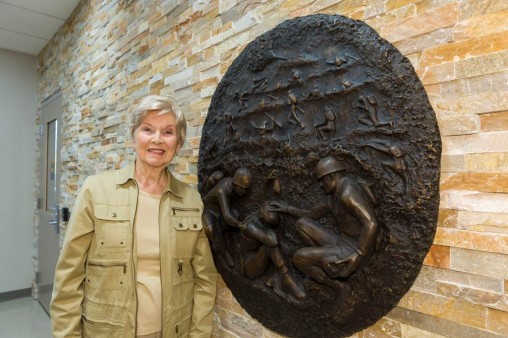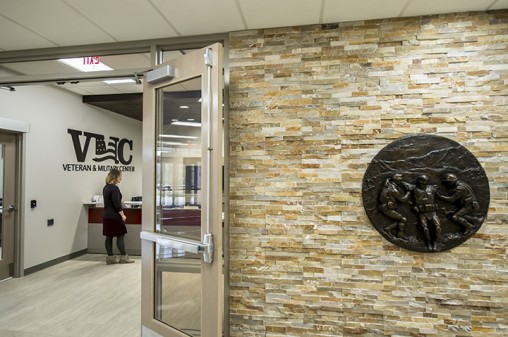
Dayton artist Virginia Hess is creating five large bronze medallions to adorn the stone façade of Wright State’s newly renovated Veteran and Military Center in Allyn Hall.
She pulls a clean white handkerchief from her pocket and begins softly polishing the figures in the shield-sized bronze medallion.
The central figure is a soldier with a bleeding head wound suffered in the Battle of Leyte Gulf during World War II. A shrapnel dent the size of a fist craters his helmet.
The sculpture, an agonizing tableau of military sacrifice, sprang directly from the heart of Virginia Hess, the artist with the handkerchief who captured her late husband’s wounded state.
The medallion is one of two that hang on the stone façade of Wright State University’s newly renovated Veteran and Military Center in Allyn Hall.
“I feel like they’re at home,” Hess said of the medallions. “I feel very strongly about our military. I don’t think they get nearly enough credit. They make so many sacrifices for us. The more I can do for the veterans, I will.”
Not only did her husband serve in the Army during World War II, but Hess herself worked as an illustrator during the war for the Air Force. She would go on to become an acclaimed artist and sculptor.
After designing the bronze medallions to be displayed at Stubbs Park in her home of Centerville, Hess offered to make replicas for Wright State’s renovated Veteran and Military Center, which will have a ribbon-cutting Thursday, Nov. 13, from 3 to 6 p.m.
The one medallion depicts her husband, Fredrick, who was seriously wounded. He is flanked by a minister and Hess’ brother, who was a medic during World War II. The other medallion depicts Marines in contemporary uniforms with a drone looking down from the sky.

The bronze medallions outside the renovated Veteran and Military Center will represent each branch of the U.S. armed services.
Hess is currently making three more medallions exclusively for the Wright State military center. She does the originals in clay and takes them to a foundry, where a mold is made. The molds are lined with wax, which is then burned out and replaced with metal. The new medallions will depict military personnel in the Air Force, Navy and Coast Guard.
Hess, who grew up in New Carlisle, Ohio, the daughter of pharmacists, was interested in art as long as she can remember.
“I used to get the National Geographic maps and draw all over the back of them, to my parents’ dismay,” she said.
When Hess was 11, she won the first of several scholarships to study at the Dayton Art Institute on Saturdays. She graduated high school at 16 and got the job as an illustrator at what would become Wright-Patterson Air Force Base.
She produced silhouettes of U.S., foreign and enemy aircraft. The silhouettes were put on cards and in books and distributed to military personnel so that they would not shoot down their own planes by mistake.
“It taught me to have a steady hand, to discipline myself,” she said. “And it gave me enough money to take flying lessons.”
Hess once got security clearance to study and draw pictures of a captured Japanese Zero, a long-range fighter that during the final years of World War II was adapted for use in kamikaze operations.
“I would go out on the flightline and look at the plane and draw different details,” she recalled. “I got inside and looked around. It was constructed of bamboo and rags tying the bamboo together. I couldn’t believe it. I was surprised at how maneuverable it was and so cheaply constructed.”
In 1943, Hess left to study art at a school in Virginia and later at the Art Academy in Cincinnati. She graduated from the University of Dayton with her Bachelor of Fine Arts degree.
Over the years she produced greeting cards and also worked for foundries and a bronzed-shoe company. And she taught art for 25 years, teaching at the Dayton Art Institute, the Art Academy in Cincinnati and at the Springfield Art Museum.
Her bronze busts of Charles Taylor, who built the first aircraft engine for the Wright brothers, sit in 27 locations around the world. There’s one in France, the Smithsonian Institution, the U.S. Air Force Academy, Wright-Patterson Air Force Base and Wright State University’s Dunbar Library.
Hess has strong ties to Wright State.
She was a board member for Friends of the Libraries, which support the University Libraries’ collections and programs. Her son, photographer Peter Hess, attended Wright State and worked for the university as a photographer in the 1970s. Her daughter, Kris, graduated from Wright State with her bachelor’s degree in education. And Hess’ husband, who died eight years ago, donated his body to Wright State as part of the Boonshoft School of Medicine’s anatomical gift program.
“It’s an entirely different feeling here than any other university I’ve worked with,” said Hess. “There’s a feeling of compassion and friendship and caring here that you don’t feel at any other university. They’re so interested in helping everybody.”
Wright State is engaged in a $150 million fundraising campaign that promises to further elevate the school’s prominence by expanding scholarships, attracting more top-flight faculty and supporting construction of state-of-the-art facilities.
Led by Academy Award-winning actor Tom Hanks and Amanda Wright Lane, great grandniece of university namesakes Wilbur and Orville Wright, the campaign has raised more than $107 million so far.
Hess said she maintains her passion for creating art because it gives her a reason to get up in the morning.
“I don’t like going on vacations because my hands get hungry,” she said. “I’ve been on cruises and I usually ended up in the stateroom with some of my sculptures. It’s just part of me.”
Read more about the renovated Veteran and Military Center >>

 Bottom Line, Wright State partnership aims to increase access to college
Bottom Line, Wright State partnership aims to increase access to college  Wright State’s nursing program celebrates 50th anniversary
Wright State’s nursing program celebrates 50th anniversary  Wright State celebrates Student Success Champions
Wright State celebrates Student Success Champions  Wright State gold team captures 2024 Horizon League team title, Flynn individual champion
Wright State gold team captures 2024 Horizon League team title, Flynn individual champion  118 medical students to graduate from Wright State’s Boonshoft School of Medicine April 28
118 medical students to graduate from Wright State’s Boonshoft School of Medicine April 28 